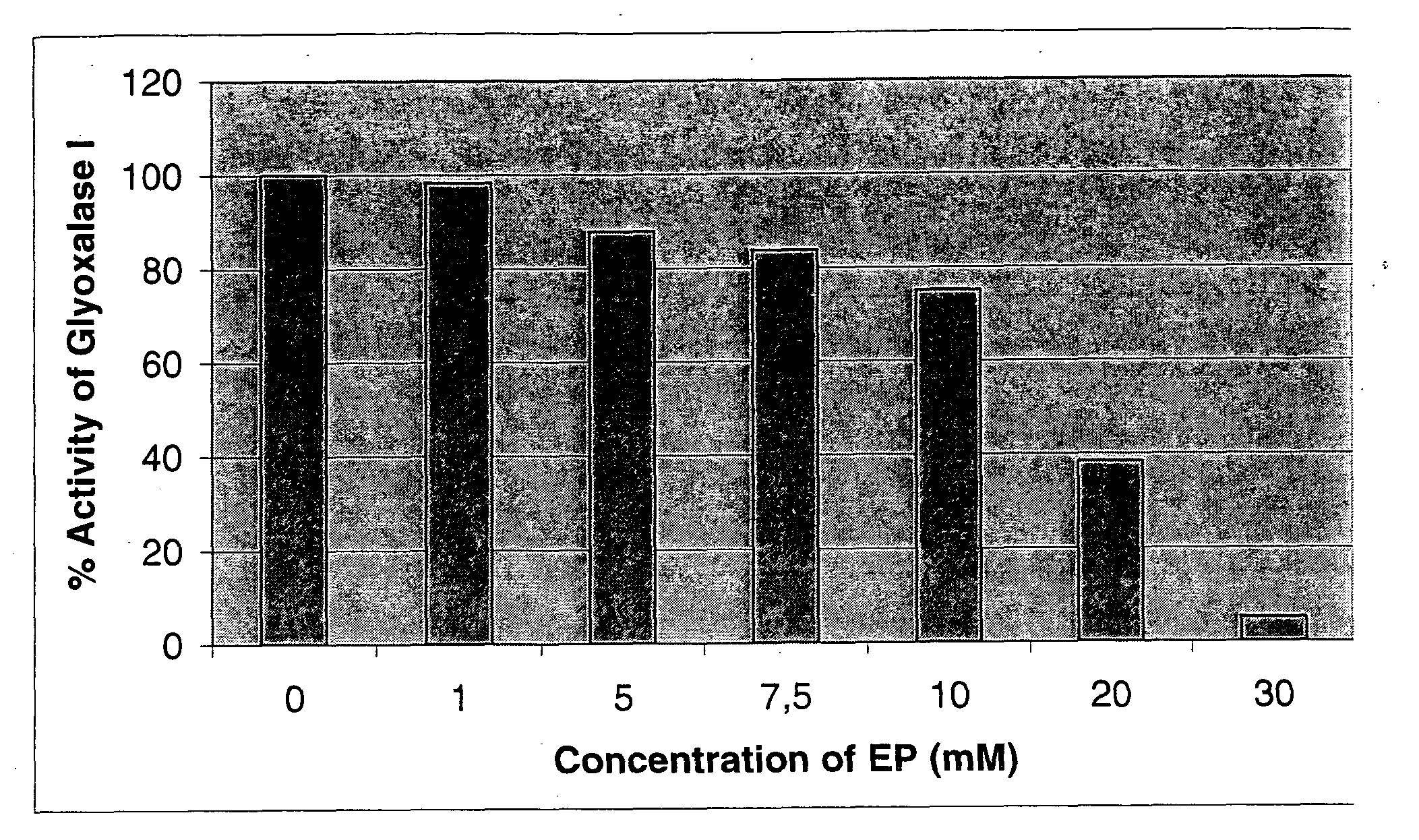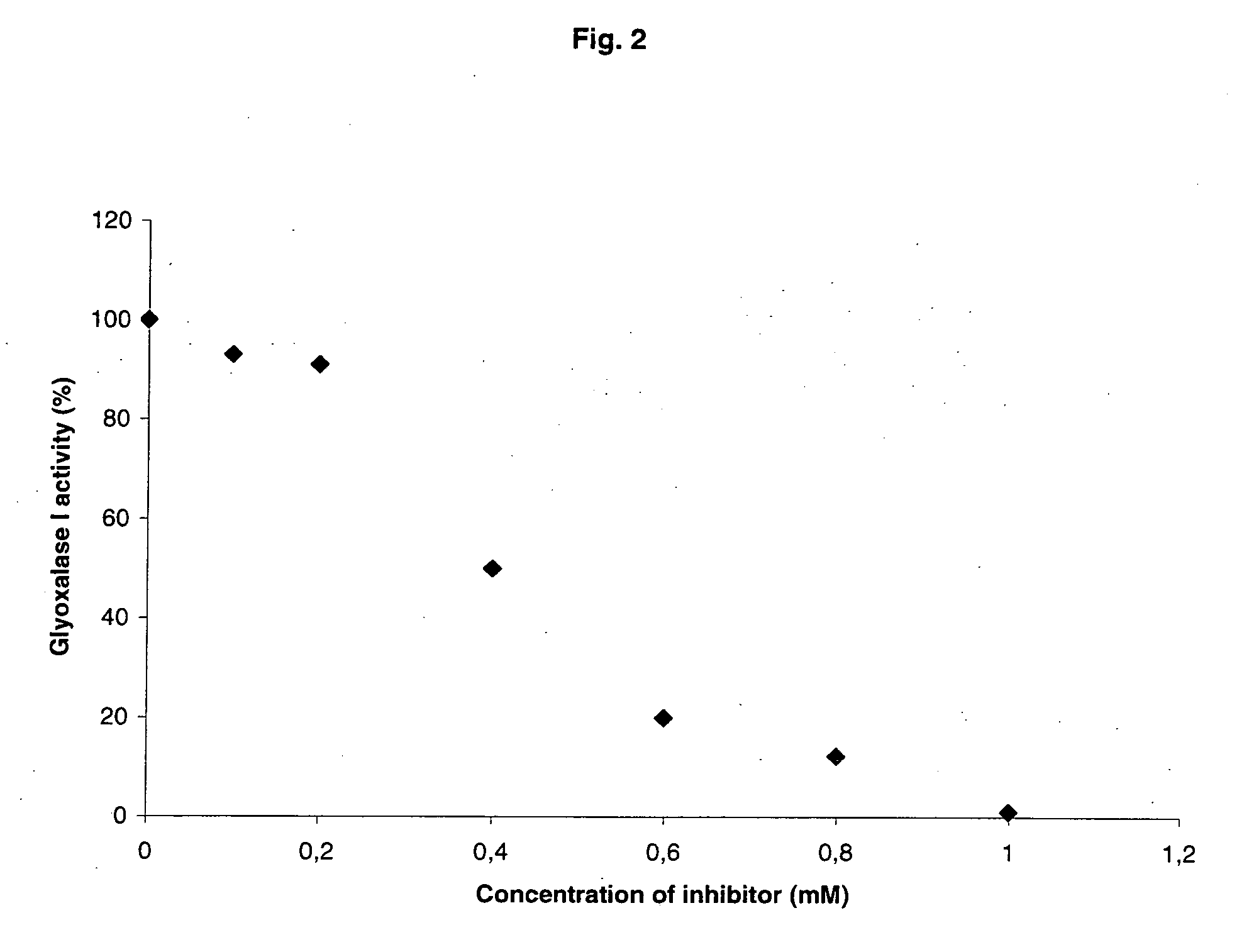Substances and Pharmaceutical Compositions for the Inhibition of Glyoxalases and Their Use As Anti-Fungal Agents
a technology of glyoxalase and pharmaceutical composition, which is applied in the direction of biocide, plant growth regulator, animal husbandry, etc., can solve the problems of difficult treatment, many fungi are known to infect and damage plants, and systemic fungal infections are life-threatening diseases that are difficult to treat, so as to increase the activity of glyoxalase, increase the activity of glycolytic metabolism, and increase the production
- Summary
- Abstract
- Description
- Claims
- Application Information
AI Technical Summary
Benefits of technology
Problems solved by technology
Method used
Image
Examples
example 1
Inhibition of the Enzymatic Activity of Glyoxalase I of Yeast by Ethyl Pyruvate (EP)
[0234]Determination of glyoxalase I activity was performed according to the general protocol as described above. The influence of ethyl pyruvate on enzyme activity was investigated by addition of increasing concentrations of EP (Sigma; no. E4,780-8; lot. S18972-513) to the measuring reagent.
[0235]The experiments (FIG. 1) show that EP inhibits the reaction of yeast glyoxalase I in a concentration dependent manner.
example 2
Inhibition of Yeast Glyoxalase I by Compounds of the General Formula (I), (II), and (III), Respectively
[0236]Determination of glyoxalase I activity was performed according to the general protocol as described above. The influence of compounds of the general formula (I), (II), and (III) on the activity of the enzyme was investigated by addition of increasing concentrations of these compounds to the preparation. The IC50-values were calculated from inhibition curves of each compound.
[0237]The data (Table 3) show that alkyl 2-oxo-derivatives inhibit the enzymatic activity of yeast glyoxalase I with different IC50s, while the alkyl 2-hydroxy-derivatives revealed no inhibitory effect at all. Thus, the experiments demonstrate that alkyl 2-hydroxy-derivatives are prodrugs which must be activated to the respective 2-oxo-derivatives in living cells or organisms.
TABLE 3IC50 GLOI*Alkyl 2-Oxo-DerivativesEthyl 2-oxobutyrateCH3—CH2—O—CO—CO—CH2—CH31.8 mM Butyl pyruvateCH3—CH2—CH2—CH2—O—CO—CO—CH37....
example 3
Effect of Prodrugs
[0238]The compounds of the general formula (II) and / or (III) can act as prodrug in the sense that the compounds are activated by enzymes within cells or in the organism, or are oxidized in vitro by addition of a suitable oxidant.
[0239]In cells or organisms lacking such activation systems the compounds of the general formula (II) and / or (III) remain inefficient. This is demonstrated by the effect of EP and LEL on the activity of glyoxalase I and the proliferation of tumor cells as well as yeast cells.
TABLE 4Inhibition ofInhibition of cellenzymeproliferationyeast GLO ILNCaPYeast cellsEthyl+++pyruvateEthyl L-−+−lactate
[0240]The experiment (Table 4) shows that alkyl 2-hydroxy derivatives have to be activated into alkyl 2-oxo-derivatives by endogenous activation systems to inhibit cell proliferation via inhibition of GLO1. In contrast to human tumor cells (LNCaP), yeast cells lack enzyme systems for transformation of alkyl 2-hydroxy derivatives into alkyl 2-oxo-derivati...
PUM
| Property | Measurement | Unit |
|---|---|---|
| pH | aaaaa | aaaaa |
| humidity | aaaaa | aaaaa |
| humidity | aaaaa | aaaaa |
Abstract
Description
Claims
Application Information
 Login to View More
Login to View More - R&D
- Intellectual Property
- Life Sciences
- Materials
- Tech Scout
- Unparalleled Data Quality
- Higher Quality Content
- 60% Fewer Hallucinations
Browse by: Latest US Patents, China's latest patents, Technical Efficacy Thesaurus, Application Domain, Technology Topic, Popular Technical Reports.
© 2025 PatSnap. All rights reserved.Legal|Privacy policy|Modern Slavery Act Transparency Statement|Sitemap|About US| Contact US: help@patsnap.com



